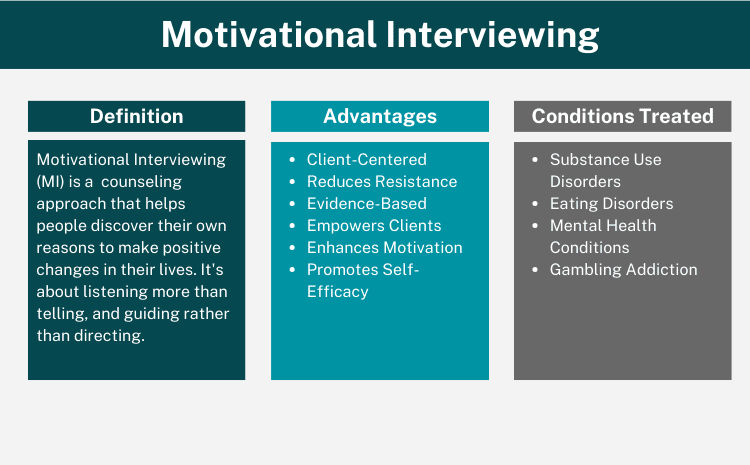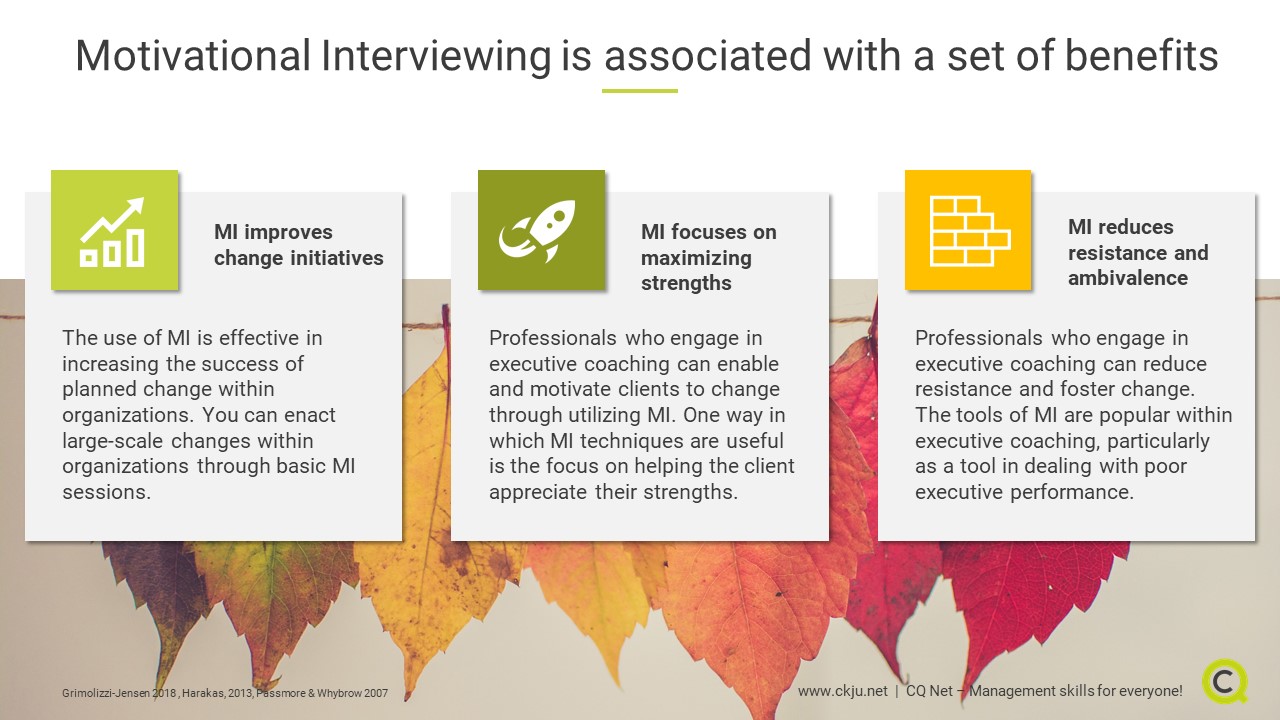Unlocking Change for Healthier Lifestyle in Seniors: The Power of Motivational Interviewing

Embracing a
healthier lifestyle is a journey that can benefit individuals of all ages, but
it can be especially transformative for seniors. As we age, our health becomes
increasingly vulnerable to the effects of time, habits, and circumstances.
However, with the right mindset and support, seniors can unlock a vibrant and
healthy future. Motivational Interviewing (MI) is a powerful tool that can help
facilitate this change. By harnessing the principles of MI, healthcare
professionals and loved ones can empower seniors to overcome ambivalence, build
confidence, and cultivate sustainable habits that enhance their overall
well-being. In this blog post, we'll delve into the world of Motivational
Interviewing and explore its vast potential for unlocking positive change and
healthier lifestyles in seniors.
History
Motivational
Interviewing (MI) was developed in the 1980s by William R. Miller and Stephen
Rollnick, two psychologists who sought to create a person-centered,
goal-oriented approach to facilitating behavior change. Initially, MI was used
to address addiction and substance abuse, but its applications have since
expanded to various fields, including healthcare, mental health, and social
work.
Motivational
Interviewing is defined as "a collaborative, goal-oriented style of
communication with particular attention to the language of change." It is
designed to strengthen personal motivation for and commitment to a specific
goal by eliciting and exploring the person's own reasons for change within an
atmosphere of acceptance and compassion." (Miller & Rollnick, 2013)
Benefits
of using MI for Seniors to Address their Health Concerns
MI is a powerful tool for addressing common health concerns in seniors, such as medication adherence, physical inactivity, and poor nutrition. By using MI, healthcare providers can empower seniors to take ownership of their health and make positive lifestyle changes.
For example, MI can help seniors overcome barriers to medication adherence, such as forgetfulness or concerns about side effects. Through open-ended questions and reflective listening, healthcare providers can explore seniors' motivations and concerns, and help them develop strategies to improve adherence.
MI can also address physical inactivity, a common concern in seniors, by exploring their values and goals related to physical activity. By highlighting the benefits of exercise, such as improved mobility and balance, and exploring small, achievable steps towards increased activity, healthcare providers can help seniors build confidence and motivation to engage in regular physical activity.
Additionally, MI can help seniors improve their nutrition by exploring their eating habits and values related to food. By identifying small, achievable changes, such as increasing fruit and vegetable intake, and exploring ways to make healthy eating easier, healthcare providers can help seniors develop healthier eating habits.
Key Components of MI
1. Express
Empathy
Expressing
empathy involves acknowledging and understanding an individual's perspective,
feelings, and experiences. It's essential to create a supportive and
non-judgmental environment, helping the person feel heard and understood.
Examples
Reflective
Listening:
Patient:
"I've been struggling to manage my diabetes, and I feel so
overwhelmed."
MI
Response: "I can imagine how frustrating that must be for you. It sounds
like you're feeling really overwhelmed by the demands of managing your
diabetes."
Acknowledging
Emotions:
Patient:
"I'm so angry that I have to deal with this chronic pain."
MI
Response: "I can see that you're really angry about this. It's
understandable to feel that way when your body is not cooperating."
Validating
Experiences:
Patient:
"I feel like I've tried everything to lose weight, but nothing
works."
MI
Response: "I can understand why you'd feel that way. It sounds like you've
been working really hard to make changes, and it's discouraging when you don't
see the results you want."
Empathetic
Statements:
Patient:
"I'm just so tired of feeling tired all the time."
MI
Response: "I can imagine how exhausting that must be for you. It sounds
like you're feeling really drained, both physically and emotionally."
Tips
- Use
reflective listening skills to paraphrase and summarize the individual's
statements.
-
Acknowledge and validate their emotions, even if you don't agree with their
perspective.
- Show
understanding and empathy through nonverbal cues like nodding, maintaining eye
contact, and open body language.
- Avoid
giving unsolicited advice or trying to fix the problem immediately.
By
expressing empathy, you create a safe and supportive environment, helping
individuals feel comfortable exploring their motivations and goals.
2. Develop Discrepancy
Developing
discrepancy involves helping individuals recognize the gap between their
current behavior and their desired goals or values. This component aims to
increase awareness of the contradictions between their current situation and
their aspirations, creating a sense of tension or discomfort that can motivate
change.
Individuals
often experience conflicting desires, uncertainty, or mixed feelings about
changing their behavior known as ambivalence. Acknowledging and exploring
ambivalence can help individuals work through their doubts and increase
motivation.
Examples:
Exploring
Goals and Values:
MI
Practitioner: "What's most important to you in life?" (identifying
values)
Patient:
"My health and family."
MI Practitioner:
"How does your current smoking habit align with those values?"
Highlighting
Contrasts:
MI
Practitioner: "You've mentioned wanting to lose weight, but you're still
consuming high-calorie foods regularly. Can you help me understand what's
driving that choice?"
Examining
Current Behavior:
MI
Practitioner: "How does your current sedentary lifestyle fit with your
goal of participating in the overseas hiking adventure next year?"
Exploring
Ambivalence:
MI
Practitioner: "On one hand, you want to quit drinking, but on the other
hand, you enjoy socializing with friends who drink. Can you tell me more about
that tension?"
Tips
- Help
individuals clarify their goals and values.
- Gently
highlight contradictions between current behavior and desired outcomes.
- Explore ambivalence
and mixed feelings without judgment.
- Avoid
confrontational or accusatory language.
- Use
open-ended questions to encourage self-reflection.
By
developing discrepancy and exploring ambivalence, individuals become more aware
of the need for change and more motivated to take action towards their goals.
3. Avoid
Argumentation
Avoiding
argumentation involves refraining from confrontational or adversarial
interactions that can reinforce resistance to change. Argumentation can lead to
defensiveness, hurt relationships, and decreased motivation.
Why Avoid Argumentation
-
Argumentation can:
- Reinforce resistance to change
- Damage the therapeutic relationship
- Increase defensiveness
- Decrease motivation
- Create power struggles
Examples of Argumentation
-
Confronting or accusing language
-
Challenging or disputing an individual's perspective
- Using
labels or diagnoses in a confrontational manner
- Imposing
one's own views or solutions
Alternatives to Argumentation
Reflective
Listening:
MI
Practitioner: "I understand you're not ready to quit smoking yet. Can you
help me understand what's keeping you from quitting?"
Empathic
Statements:
MI
Practitioner: "I can see why you'd feel that way. It sounds like you're
really struggling with this issue."
Open-Ended
Questions:
MI
Practitioner: "What do you think would need to happen for you to consider
changing your behavior?"
Exploring
Ambivalence:
MI
Practitioner: "Can you tell me more about the pros and cons of changing
your behavior?"
Tips
- Focus on
understanding the individual's perspective
- Use
non-confrontational language
- Avoid
taking a confrontational tone or stance
- Reframe
resistance as an opportunity for exploration
-
Prioritize empathy and understanding over "winning" an argument
By avoiding
argumentation, you create a safe and supportive environment, allowing
individuals to explore their motivations and goals without becoming defensive
or resistant to change.
4. Roll with Resistance
Rolling
with resistance involves acknowledging and accepting an individual's resistance
to change, rather than confronting or challenging it. This approach helps to
reduce defensiveness, build trust, and create a supportive environment for
exploration and growth.
Why Roll with Resistance
-
Resistance is a natural part of the change process
-
Confronting resistance can increase defensiveness and decrease motivation
- Rolling
with resistance can help build trust and rapport
-
Resistance can provide valuable information about an individual's concerns and
motivations
Examples of Rolling with Resistance
Reflective
Listening:
Patient:
"I don't want to give up my favorite Kentucky fried chicken."
MI
Practitioner: "You're really attached to those foods. Can you tell me more
about what makes them so important to you?"
Acknowledging
Concerns:
Patient:
"I'm worried that exercising will hurt my knees."
MI
Practitioner: "That's a valid concern. Let's explore some ways to exercise
that might be easier on your knees."
Exploring
Ambivalence:
Patient:
"Part of me wants to quit smoking, but another part of me doesn't want to
give up the habit."
MI
Practitioner: "It sounds like you're feeling a bit torn. Can you tell me
more about both sides of that argument?"
Tips
- Avoid
confronting or challenging resistance
- Use
reflective listening to acknowledge and understand resistance
- Explore
the underlying concerns and motivations driving resistance
- Reframe
resistance as an opportunity for growth and exploration
-
Prioritize empathy and understanding over "overcoming" resistance
By rolling
with resistance, you create a supportive environment where individuals feel
comfortable exploring their concerns and motivations, ultimately increasing
their readiness for change.
5. Support Self-Efficacy
Supporting self-efficacy involves empowering individuals to believe in their ability to change and take control of their lives. This component aims to enhance confidence, motivation, and self-trust, leading to increased self-efficacy and a greater likelihood of successful behavior change.
Why Support Self-Efficacy
-
Self-efficacy is a strong predictor of behavior change
-
Individuals with high self-efficacy are more likely to take action and maintain
change
-
Self-efficacy can be developed and strengthened through supportive interactions
Examples of Supporting Self-Efficacy
Encouraging
Small Wins:
MI
Practitioner: "You've been able to cut down on sugar for the past week now.
That's a great start! How did you manage that?"
Highlighting
Strengths:
MI
Practitioner: "I've noticed you're really good at planning ahead. How can
we apply that skill to your exercise goals?"
Fostering
Self-Reflection:
MI
Practitioner: "What do you think you did differently this time that helped
you succeed in reducing your drinking?"
Exploring
Past Successes:
MI
Practitioner: "Can you tell me about a time when you overcame a difficult
challenge? What skills did you use then that could help you now?"
Tips
- Focus on
strengths and past successes
- Encourage
small, achievable steps towards change
- Foster
self-reflection and self-awareness
- Avoid
criticizing or correcting individuals
- Emphasize
personal control and agency
By
supporting self-efficacy, you help individuals develop the confidence and
motivation needed to take control of their behavior and make lasting changes.
Core Skills
These
skills are essential for creating a supportive and non-judgmental environment,
allowing individuals to:
- Explore
their motivations and goals
- Develop
self-awareness and insight
- Build
confidence and self-efficacy
- Resolve
ambivalence and uncertainty
- Take
ownership of their behavior change
By
mastering these core skills, MI practitioners can:
- Establish
a strong therapeutic relationship
-
Facilitate open and honest communication
- Empower
individuals to drive their own behavior change
- Enhance
motivation and commitment to change
These
skills are the foundation of MI, and when used effectively, can lead to
increased success in behavior change and improved outcomes.
Here's an elaboration on the core skills of Motivational Interviewing
Open-Ended Questions
- Encourage
exploration and reflection
- Begin
with what, how, or why
- Avoid leading
questions or ones that can be answered with a simple "yes" or
"no"
- Examples:
- "What brings you here today?"
- "How do you think you can apply this
to your life?"
- "Why is this goal important to
you?"
Reflective Listening
-
Paraphrase and summarize what the individual has said
- Reflect
underlying emotions, motivations, and values
- Use
nonverbal cues like nodding and maintaining eye contact
- Examples:
- "Just to make sure I understand,
you're saying that..."
- "I hear that you're feeling really
frustrated with this situation."
- "So, what I'm hearing is that you
want to..."
Affirmations
-
Acknowledge and reinforce positive statements or actions
- Highlight
strengths and efforts
- Use
specific and sincere language
- Examples:
- "I really appreciate your
honesty."
- "That takes a lot of courage to
share."
- "You're doing a great job of taking
small steps towards your goal."
Summaries
- Provide concise overviews of discussions
- Highlight key points, motivations, and goals
- Check for understanding and ensure accuracy
- Examples:
-
"Just to summarize, you've told me that..."
-
"So, what we've discussed so far is..."
- "To make sure I understand, can you summarize the main points for me?"
These core skills help create a supportive and non-judgmental environment, allowing individuals to explore their motivations and goals, and ultimately, drive behavior change.
Here's a real-life example of using Motivational Interviewing (MI) as an education tool
Patient: Mdm.
Tan, a 75-year-old woman with type 2 diabetes
Goal:
Improve medication adherence and increase physical activity
MI Session:
Health Coach:
"Mdm. Tan, can you tell me about
your experience with taking your diabetes medication?"
Mdm. Tan:
"Honestly, I forget sometimes. And I don't like the side effects."
Health Coach:
"I understand. It can be tough to remember and deal with side effects.
What's most important to you about managing your diabetes?"
Mdm. Tan:
"I want to stay healthy and independent."
Health Coach:
"That's great. How does taking your medication fit into that goal?"
Mdm. Tan:
"I guess it's important, but it's hard to remember."
Health Coach:
"Okay. Let's explore some ways to make it easier. What do you think would
help you remember to take your medication?"
Mdm. Tan:
"Maybe a pill box or a reminder on my phone."
Health Coach:
"Those are great ideas. And what about increasing your physical activity?
What are your thoughts on that?"
Mdm. Tan:
"I know I should, but I don't like going to the gym."
Health Coach:
"That's okay. There are other ways to be active. What do you enjoy
doing?"
Mdm. Tan:
"I like walking my dog."
Health Coach:
"That's great! We can start with small goals, like taking a short walk
with your dog each day. How does that sound?"
Outcome:
Mdm. Tan agreed
to use a pill box and set reminders on her phone to improve medication
adherence. She also committed to taking short walks with her dog each day, with
the goal of increasing her physical activity.
MI
Techniques Used:
-
Open-ended questions
-
Reflective listening
- Exploring
ambivalence
-
Identifying and building on motivations
- Setting
small, achievable goals
This example demonstrates how MI can be used as an education tool to empower patients to take ownership of their health and make positive lifestyle changes. By using MI techniques, the health educator helped Mrs. Johnson explore her motivations, address her concerns, and develop strategies to improve her medication adherence and physical activity.
















Comments
Post a Comment